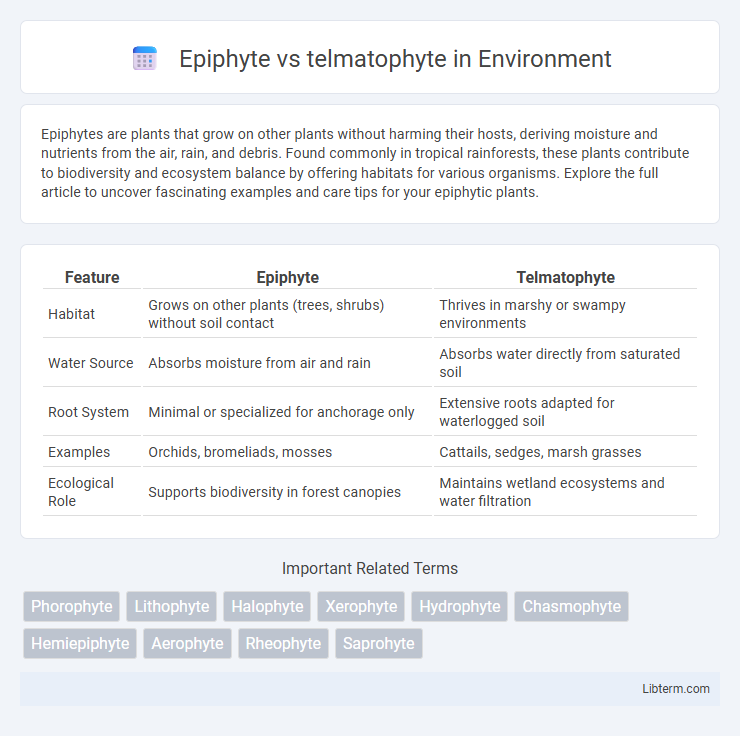Epiphytes are plants that grow on other plants without harming their hosts, deriving moisture and nutrients from the air, rain, and debris. Found commonly in tropical rainforests, these plants contribute to biodiversity and ecosystem balance by offering habitats for various organisms. Explore the full article to uncover fascinating examples and care tips for your epiphytic plants.
Table of Comparison
| Feature | Epiphyte | Telmatophyte |
|---|---|---|
| Habitat | Grows on other plants (trees, shrubs) without soil contact | Thrives in marshy or swampy environments |
| Water Source | Absorbs moisture from air and rain | Absorbs water directly from saturated soil |
| Root System | Minimal or specialized for anchorage only | Extensive roots adapted for waterlogged soil |
| Examples | Orchids, bromeliads, mosses | Cattails, sedges, marsh grasses |
| Ecological Role | Supports biodiversity in forest canopies | Maintains wetland ecosystems and water filtration |
Understanding Epiphytes: Definition and Characteristics
Epiphytes are plants that grow non-parasitically on other plants or objects, obtaining moisture and nutrients from the air, rain, and debris around them, distinguishing them from telmatophytes, which thrive in waterlogged or swampy environments. Characterized by adaptations such as aerial roots and specialized leaves, epiphytes include common species like orchids, bromeliads, and ferns. Their ecological role contributes to biodiversity by creating unique microhabitats and influencing nutrient cycles within forest canopies.
What Are Telmatophytes? Key Features Explained
Telmatophytes are plants adapted to grow in swampy or marshy environments, characterized by their ability to thrive in waterlogged, oxygen-poor soils. Key features include specialized root structures for anchorage and nutrient absorption in wet substrates, as well as physiological adaptations to tolerate anaerobic conditions. Unlike epiphytes, which live on other plants without soil contact, telmatophytes rely on saturated terrestrial habitats for survival.
Epiphyte vs Telmatophyte: Core Differences
Epiphytes grow on other plants without harming their hosts, deriving moisture and nutrients from the air and rain, while telmatophytes thrive in water-saturated environments like marshes or swamps, obtaining nutrients from the soil and water. Epiphytes, such as orchids and ferns, exhibit adaptations like aerial roots for anchorage, whereas telmatophytes, including cattails and sedges, have specialized structures to withstand prolonged water immersion. Understanding these habitat and physiological differences clarifies their ecological roles and evolutionary adaptations.
Ecological Roles of Epiphytes
Epiphytes contribute significantly to biodiversity and ecosystem dynamics by providing habitat and food resources for numerous organisms, including insects, birds, and amphibians. They enhance nutrient cycling and water retention in forest canopies, facilitating microhabitats that support diverse ecological interactions. Epiphytes also play a vital role in stabilizing microclimates and promoting humidity regulation within tropical and temperate forest ecosystems.
Ecological Roles of Telmatophytes
Telmatophytes, commonly found in wetland and marsh ecosystems, play a crucial role in water filtration and nutrient cycling, enhancing water quality by trapping sediments and absorbing pollutants. Their dense root systems stabilize soil, prevent erosion, and create habitats for diverse aquatic and terrestrial species, contributing to ecosystem biodiversity. By maintaining hydrological balance, telmatophytes support flood regulation and carbon sequestration, which are vital for climate change mitigation.
Adaptations for Survival: Epiphytes
Epiphytes exhibit specialized adaptations for survival, including aerial root systems that absorb moisture and nutrients directly from the air, bypassing the need for soil. Their leaves often possess waxy coatings and trichomes to minimize water loss and capture dew or fog efficiently. These adaptations enable epiphytes to thrive in canopy environments with limited access to water and nutrients.
Adaptations for Survival: Telmatophytes
Telmatophytes exhibit specialized root systems that thrive in saturated, waterlogged soils by facilitating oxygen uptake in hypoxic conditions. Their vascular tissue adaptations allow efficient nutrient transport despite frequent submersion, supporting growth in marshy or swampy habitats. These plants often develop aerenchyma, air-filled tissues that enhance buoyancy and gas exchange, ensuring survival in anaerobic environments.
Habitat Preferences: Epiphytes vs Telmatophytes
Epiphytes primarily inhabit arboreal environments, growing on the surface of trees and deriving moisture and nutrients from the air and rain. Telmatophytes are specialized for aquatic or semi-aquatic habitats, thriving in wetlands, marshes, or boggy soils with high water content. The contrasting habitat preferences highlight epiphytes' adaptation to aerial niches and telmatophytes' reliance on saturated substrates for survival.
Importance in Ecosystems: Comparative Analysis
Epiphytes contribute significantly to biodiversity by providing microhabitats and enhancing nutrient cycling in tropical and temperate forests, while telmatophytes play a crucial role in wetland ecosystems by stabilizing soil and supporting aquatic food webs. Epiphytes increase canopy complexity and facilitate water retention through their unique root systems, whereas telmatophytes improve water quality and reduce erosion via their extensive rhizome networks. The comparative ecological importance of epiphytes and telmatophytes underscores their complementary roles in maintaining ecosystem resilience and function across distinct habitats.
Epiphyte and Telmatophyte Examples and Identification
Epiphytes, such as orchids, bromeliads, and ferns, grow non-parasitically on other plants, deriving moisture and nutrients from the air and rain, and are commonly identified by their aerial root systems and lack of soil contact. Telmatophytes, including many species of marsh grasses, sedges, and reeds, thrive in waterlogged or swampy environments, characterized by their adaptations to saturated soil conditions and hydrophytic structures like aerenchyma. Identification relies on habitat observation, where epiphytes occupy arboreal niches, while telmatophytes are found rooted in aquatic or semi-aquatic substrates.
Epiphyte Infographic

 libterm.com
libterm.com